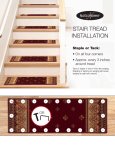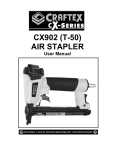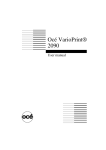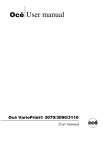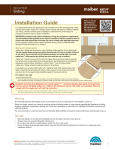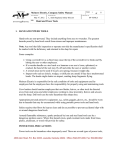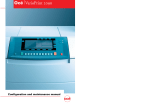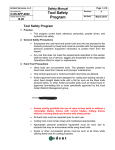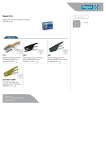Download INTRODUCTION DELIVERY SAFETY REGULATIONS SYMBOLS
Transcript
GB INTRODUCTION This Operator’s Manual describes the Rapid 101E. Read the operator’s manual carefully before using the machine. The manual contains safety regulations and descriptions of checks on parts which are critical for safety, together with directions for the correct use and maintenance of the machine. The figures will be found on the cover fold-out. DELIVERY The scope of delivery is as follows: - Rapid 101E - Plastic bag containing: - Socket head wrench - Guide plate 66/8 - Guide plate 44/8 - Operator’s Manual SAFETY REGULATIONS - The machine may only be used by personnel with knowledge of the safety regulations and correct handling as described in this manual. - The visor must always be folded down when stapling. - Only the papers (or other objects) to be stapled should be put into position under the visor. - It must not be possible to staple with the visor in the upper position. Check on this every day as described in the section “Checking safety functions”. - The machine must be turned off before it is moved. - The machine must be connected to an electric socket which has a protective earth. - The machine must not be subjected to moisture. It must not be located in a position where rain or splashes of water can fall on it. - Repairs and other measures, besides those described in this manual, must be carried out by authorised service personnel. - Repair of faults or damage to the machine or its electrical connection must be carried out by authorised service personnel. SYMBOLS Symbols in this manual Read the operator’s manual carefully and make sure you understand it properly before using the machine. Warning text. Information critical for safety follows after this symbol. 39 GB Symbols on the machine See figure 1. A Forbidden to put fingers underneath the visor when it is folded down. B Adjusting the stapling power. C Rating plate with the following data: Manufacturer. Type designation of machine. Serial number. Electrical data. Max. number of staples per minute. Marking for type approval. CE mark for compliance according to EU Directive (This mark will be found on machines sold in certain countries). Year of manufacture. D The machine complies with the German requirements for radio interference suppression. (This mark will be found on machines sold in certain countries). E The machine has been tested and approved by TÜV. (This mark will be found on machines sold in certain countries). F The machine has been tested and approved by UL and CSA. (This mark will be found on machines sold in certain countries). DESCRIPTION OF RAPID 101E The Rapid 101E is an electrically powered table stapler intended for saddle and flat stapling. The parts of the machine are shown in figure 2. G Visor O Trigger H Work table P Wheel for adjusting stapling force J External paper guide K Internal paper guide R Switch L S Pedal Locking handle for work table M Magazine T Clamp screw N Stapling anvil U Guide plate The work table can be set in two positions: Horizontal, for flat stapling Angled, for saddle stapling. The machine is operated by pressing down the foot pedal or automatically by pushing the stapling object into the stapling position. When using the automatic method the position of the trigger should be adjusted so that the staples come in the desired position relative to the edge of the stapling object. Saddle stapling can only be done with the pedal. 40 GB The Rapid 101E is available with various types of magazine suitable for staples with different wire thickness. Staples of different types are designated 44 and 66. Always use original Rapid staples. The Rapid 101E is designed for staples with a leg length of 6 and 8 mm. To ensure proper stapling the leg length should be at least 3 mm longer than the thickness of the stapling object. The type of original Rapid staple that should be used is shown on the front of the magazine. ACCESSORIES Insert stapler Rapid 252/101 for loop staples, and loop staples type Rapid 66/6R. Stapling with loop staples can replace hole punching. See figure 8. Markings on the work table indicate the position of the paper for different hole patterns. There are marks for A4 format as well as A5, with hole centres of 70 mm and 80 mm.There are also marks for Standard Rule format (US size) with hole centres of 8˚” (216 mm). The insert stapler for loop staples is fitted in accordance with the description in the section “Replacing the insert stapler”. INSTALLATION The Rapid 101E is installed as follows: 1 Position the machine at the edge of a stable table. The base should be flush with the table edge. 2 Fix the machine on the table by tightening the clamp screw. 3 Check that the machine is stable and properly attached to the table. 4 Check that the machine is suitable for the electrical power supply available (voltage and frequency) by reading the data on the rating plate. 5 Insert the machine’s plug into the electric socket. OPERATION Adjusting the work table for saddle stapling When saddle stapling is required the work table should be angled down as follows (see figure 3): 1 Release the locking handle (L) for the work table. 2 Angle the work table down. 3 Position the work table so that the two guide pins fit into the holes in the work table. 4 Lock the work table with the locking handle. 41 GB Adjusting the work table for flat stapling When flat stapling is required the work table should be put in the horizontal position as follows (see figure 4): 1 Release the locking handle (L) for the work table. 2 Attach the work table to the two hooks. 3 Position the work table so that the two guide pins fit into the holes in the work table. 4 Lock the work table with the locking handle. Adjusting the paper guides There are two adjustable paper guides on the work table, one on the left and one on the right hand side. See figure 2. External paper guide (J) Internal paper guide (K) The external guide (J) is locked in position when it is pointing upwards. It can be released by turning it through an angle of approx. 60°. The internal guide (K) can be angled downwards but only in its outermost position. The internal guide is locked in position when it is in the vertical position. Before the internal guide can be moved it must be turned to an intermediate position at which the lock is released. Filling staples Fill the machine with staples when required as shown in figure 5: 1 Turn off the switch on the machine. 2 Lift up the visor. 3 Open the magazine by pressing down the lock. Pull out the magazine. 4 Put the staples into the magazine as shown in the figure. Use the type of staple stated on the magazine. Use only Rapid original staples. Interruptions in operation can be caused by use of the wrong type of staple. 5 Close the magazine so that it locks in the closed position. Adjusting the trigger position Automatic stapling is used only when flat stapling. When using saddle stapling the trigger should be moved to the extreme rear position. The distance between the staple and the edge of the stapling object is determined by adjusting the position of the trigger as follows. See figure 6: 42 1 Turn off the switch on the machine. 2 Lift up the visor. 3 Adjust the trigger position (O) by lightly squeezing the rider and then move the trigger along the hexagonal rod. GB Adjusting the stapling force The stapling force is adjusted using a wheel (P) at the back of the machine. The correct setting can depend on the thickness and hardness of the stapling object. The stapling force adjuster can also be used to compensate for variations in the local power supply, and when using long extension cables. When the force is set too low, this can lead to deficient stapling. When the force is set too high, this can cause unnecessary noise and wear. Flat stapling Flat stapling is carried out as follows. See figure 7: 1 Position the work table as described in the section “Adjusting the work table for flat stapling”. 2 Check that the trigger position is adjusted for the correct stapling depth. 3 Switch on the machine. An indicator lamp in the switch shows when the machine is on. Warning: Only the stapling object may be pushed under the visor. 4 Move the stapling object to the stapling position. 5 Press the pedal to staple, unless automatic stapling is being used. 6 Switch the machine off when not in use. Saddle stapling Saddle stapling is carried out as follows: 1 Position the work table as described in the section “Adjusting the work table for saddle stapling”. 2 Check that the trigger is positioned as far to the rear as possible to prevent unintentional stapling when the stapling object is moved to the stapling position. 3 Switch on the machine. An indicator lamp in the switch shows when the machine is on. Warning: Only the stapling object may be pushed under the visor. 4 Move the stapling object to the stapling position. 5 Press the pedal to staple. 6 Switch the machine off when not in use. 43 GB MAINTENANCE Checking safety functions One of the safety checks that should be done every day before the machine is used is to check on the visor’s safety function. Check the visor’s safety switch as follows: 1 Switch on the machine. 2 Lift up the visor. 3 Test whether or not the machine will staple a piece of paper with the visor up. If the machine operates with the visor in the upper position it must be switched off immediately and sent for repair. Cleaning The machine should be cleaned when required as follows: 1 Switch off the machine and pull out the plug from the electric socket before cleaning. 2 Clean the machine as required by blowing away dust and paper remnants. 3 If the machine is heavily soiled it should be cleaned with a moist rag. TROUBLE SHOOTING Some suggestions for the causes of operational interruptions. Staples not bent sufficiently - Stapling force insufficient. Increase the force with the adjusting wheel (P) at the back. - Stapling object too thick. At least 3 mm of the staple legs must penetrate through the object to ensure satisfactory results. - Stapling object is too hard. - Wrong type of staple. Check that the type of staple in use corresponds to the type stated on the magazine. Always use original Rapid staples. - The machine is worn. Send it away for service. Stapling movement is triggered but the machine does not staple 44 - Magazine empty. Check and fill the magazine with staples as described in this manual. - A staple has stuck in the discharger. Switch off the machine and carefully remove the staple that is stuck using another staple. Avoid using tools because they can easily damage the machine. - Wrong type of staple. Check that the type of staple in use corresponds to the type stated on the magazine. Always use original Rapid staples. - Magazine damaged or worn. Replace the insert stapler as described in this manual or send the machine away for service. GB Stapling movement not triggered - Power supply not turned on. Check that the machine is connected to the electric socket. Check that the lamp in the switch is illuminated when the machine is in operation. Check that there is voltage at the electric socket (a fuse may have blown). - Check that the trigger springs back again when stapling. - The machine is damaged. Send it away for service. REPLACING THE INSERT STAPLER When replacing the insert use one of the guide plates supplied with the machine and the socket head wrench. Replace the insert as follows. See figure 9: 1 Position the work table as described in the section “Adjusting the work table for saddle stapling”. 2 Remove the power supply by pulling out the plug from the electric socket. 3 Move the trigger close to the anvil. 4 Undo the two screws holding the insert using the socket head wrench. 5 Pull the insert out carefully and remove it from the machine, being careful not to damage the trigger mechanism. 6 Open the magazine on the new insert. 7 Select the guide plate that corresponds to the type of staple shown on the new insert magazine. 8 Carefully press the guide plate into the discharger on the new insert and close the magazine. 9 Position the new insert in the machine. 10 Adjust the guide plate in the anvil so that the insert assumes the correct position. 11 Screw the insert into position using the screws at the same time as the guide plate is fitted to suit the anvil. 12 Open the magazine and remove the guide plate. 13 Check on the following before switching on the machine: - That the insert is fitted straight and stable in the machine. - That the trigger is undamaged and can be adjusted to the desired position. - That the magazine can be pressed down against the anvil. 45 GB TECHNICAL SPECIFICATION Complete designation Rapid A101E Width 250 mm Length 320 mm Height 355 mm Weight 6.2 kg Max. capacity 45 sheets on flat 20 sheets on saddle (copying paper) Max. stapling depth 85 mm Staple type See front of magazine No. of staples in magazine Strip staples (66/6-8 approx. 210 staples) (44/6-8 approx. 150 staples) Equivalent noise level dB(A) at max. capacity and max. stapling force. Example: See figure 10. 910 staples in 8 hours 70 dB(A) Noise measurements carried out according to ISO 7779 with supplementary proposal “Electrical staplers: Noise test code”. The limit value 70 dB(A) equivalent noise level is a requirement in Germany for the max. noise level in general premises of the type, shops, airport check-in areas, receptions, and similar. 46











